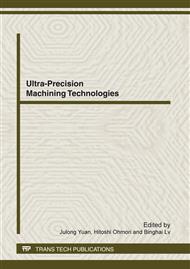p.278
p.284
p.289
p.294
p.299
p.304
p.311
p.315
p.320
Research on Tool Wear and Surface Characteristics in Ultrasonic Milling Carbon Fibre Reinforced Carbon Composite
Abstract:
The experimental research on ultrasonic vibration assisted milling non-ablating carbon fibre reinforced carbon composite was carried out by employing uncoated tungsten carbide milling cutter, in order to reduce the machining cost and improve the surface quality of workpiece. According to the experimental results, the tool wear was reduced and the surface quality of milled carbon fibre reinforced carbon composite was improved. Compared to traditional milling method, the flank wear land was narrowed and it dominated by abrasive particles wear mechanism. The wear trace was even and wide, with width of 7-8μm; while the rake face was worn in the mode of adhesion wear mechanism. Most of carbon fibres were cut off directly and there were little fracture, pull-out and delamination; the matrix phase was removed nearly in hybrid of brittle and ductile regime and surface damage was small.
Info:
Periodical:
Pages:
299-303
Citation:
Online since:
April 2012
Authors:
Keywords:
Price:
Сopyright:
© 2012 Trans Tech Publications Ltd. All Rights Reserved
Share:
Citation:


